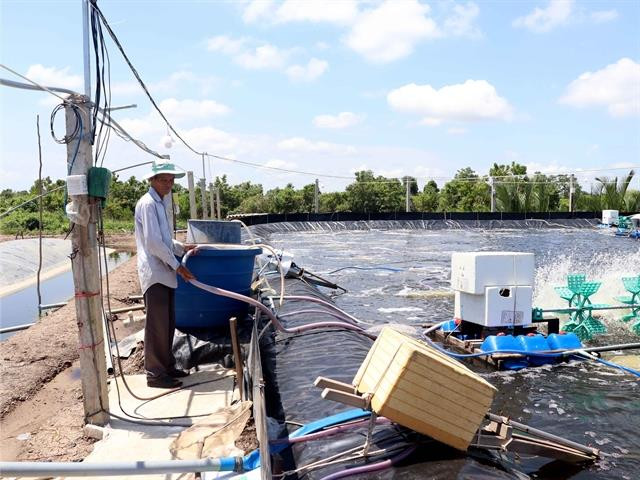 Farmer Tran Bao in Ca Mau city's Hoa Tan commune breeds shrimp under the super-intensive farming model. (Photo: VNA)
Farmer Tran Bao in Ca Mau city's Hoa Tan commune breeds shrimp under the super-intensive farming model. (Photo: VNA)Ca Mau (VNS/VNA) - The MekongDelta province of Ca Mau has developed more clean farming models for shrimp andrice that meet Vietnamese good agricultural practices (VietGAP) standards andorganic standards to meet the rising demand for them, especially in exportmarkets.
It has carried out a project to farm high-qualityshrimp and rice to VietGAP standards in Ca Mau city’s Ly Van Lam commune.
Farmers grow rice in the rainy season and raiseshrimp in the dry season in the same fields, and both are clean due to the lowuse of chemicals.
The project, implemented on a total area of 120ha,helps produce high-quality rice and shrimp, improving farmers’ incomes.
Phan Hoang Minh of Ca Mau city’s Division of Agricultureand Rural Development said the participating farmers harvested seven tonnes ofrice per hectare in the last crop, two tonnes more than in the same crop lastyear.
“The project will be expanded to an additional80ha next month when farmers begin a new rice crop.”
Pham Van Mich, director of the province’sAgriculture Seed Centre, said the project was new but proceeding on scheduleand churning out high-quality produce.
The model is especially suitable for use incoastal areas where salinity in rivers is rising due to intrusion of seawater,according to Mich.
The rice varieties planted under the projectinclude ‘tai nguyen’, ‘tep hanh’ and ‘mot bui’, which areresistant to saltwater and disease and delicious.
Nguyen Van Tranh, deputy director of theprovincial Department of Agriculture and Rural Development, said rice was oneof the four key agricultural products chosen for the agriculture restructuringplan.
The department would zone areas for growinghigh-quality VietGAP rice, he said.
Ca Mau has more than 85,000ha under rice and40,000ha of shrimp-rice farms.
It has another 280,849ha of shrimp farms, or 40percent of the country’s total, and accounts for 30 percent of the country’sshrimp exports.
The province produces 120,000 tonnes of shrimp ayear, according to its Aquaculture Sub-department.
Its shrimp are bred under various models such astraditional extensive farming, advanced extensive farming, intensive farming,and super intensive farming.
Intensive and super intensive farming are done onmore than 2,000ha, with the latter yielding an average of 40-50 tonnes ofshrimp per hectare per crop.
Thai Minh Tuan, who does intensive farming ofshrimp in Dam Doi district’s Tran Phan commune, said though the weather hadbeen unfavourable recently his shrimp did not contract serious diseases becausehe used biofloc technology to manage water quality.
Water quality and shrimp fry were the twoimportant factors for a successful shrimp crop, he said.
Many shrimp farmers in Dam Doi use biofloctechnology, helping keep diseases under control in the area.
The province has established several shrimpfarming areas that meet high quality standards including organic, VietGAP andAquaculture Stewardship Council (ASC).
Ca Mau promotes its shrimp products within thecountry and abroad.
It has created link-ups between stakeholders inshrimp production including farmers and processing companies to improve theformer’s incomes and the quality of shrimp products.
The Cai Bat Aquaculture Cooperative in Cai Nuoc district’sHoa My commune has, for instance, participated in a project to create anequitable and sustainable shrimp production chain in 2016.
The project taught the co-operative’s membersfarming techniques and elicited support from participating companies.
The companies sell inputs to the members and buytheir entire output.
Nguyen Van Lam, director of the cooperative, said:“Through the project, cooperation between the cooperative and companies in bothbuying and selling outputs has been implemented effectively.”
Members could buy shrimp fry, food and drugs atlower prices than in the market, while the company bought their shrimp at 2,000-5,000VND a kilogramme higher than market rates, he said
Last month the province established the VietnamSustainable Shrimp Alliance, with its members including shrimp processingcompanies, cooperatives representing shrimp farming households and foreignbuyers.
The alliance is expected to help create a standardclosed shrimp production chain.-VNS/VNA





























